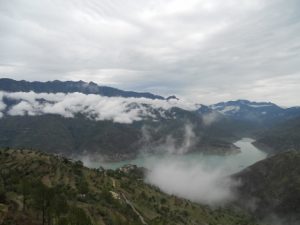The Indian government needs to drastically rethink its policy for the Himalayas to avoid a repeat of the disaster caused by flash floods in Uttarakhand this June, says the Himalayan Unity Movement (HUM).
This umbrella group of environmental NGOs working in the world’s highest mountain range has been observing September 9 as Himalaya Day for four years now. Scores of activists came together in New Delhi for the purpose on Monday. Their deliberations took on added urgency this year in the wake of the Uttarakhand disaster, as they demanded the setting up of a central ministry that would drive sustainable development in the Himalayas.
The environmentalists are particularly worried about the impacts of the plethora of hydroelectric projects being built and planned in the Himalayas. India’s Supreme Court has placed a moratorium on all such construction after the Uttarakhand flash floods.
Anil Joshi, founder of the Himalayan Environment Studies and Conservation Organisation (HESCO) said, “We need to look at the Himalayas with a new perspective. There is an urgent need to re-frame policies and revisit development plans.”
Joshi said at Monday’s meeting that HUM has been calling for a new central ministry for the Himalayan region for many years, but the demand has assumed urgency this year due to the Uttarakhand tragedy. He said the way to sustainable development was through empowering local communities “who are treasured with indigenous knowledge and can help in preserving the ecological heritage in the best possible way”.
Many speakers at the meeting talked about the loss of biodiversity in the Himalayas. Radha Bhatt, chairperson of the Gandhi Peace Foundation, pointed out that pine trees planted in the region to reap commercial benefits were causing immense harm. “The region needs trees with broader leaves for maintaining ecological balance,” she said, criticising the government for pushing commercialisation over conservation.
Other activists spoke of the adverse effects of ill-planned projects. D.P. Dimri of the NGO Uttarayani talked about a village called Kunt near Rudraprayag in Uttarakhand, where most of the soil had subsided due to the construction of a tunnel below. “There have been no significant efforts for the rehabilitation of the villagers,” he alleged.
Charu Tiwari, a journalist who has been covering the Uttarakhand disaster, was worried about the government’s reconstruction plans. He feared that the authorities were going to repeat the mistakes that had magnified the disaster in the first place. Like Joshi, he demanded that the authorities respect and use local knowledge during reconstruction.
Apart from a central ministry, there should be a separate “Himalayan environment protection task force”, demanded Jagdish Chander, secretary general of Peoples’ Action for Protection of Himalayan Environment. He said the way to have water security in the Himalayas without destroying nature would be to build small check dams every 100 metres or so.
“These dams will be helpful as only the excess water from the rivers would then flow downstream during the rainy reason. The rest of it will recharge the inner water bodies for summers and thus provide adequate water to the hills,” he said.
Most of the activists demanded a drastic reduction in the number of hydroelectric projects being built and planned in the Himalayas. They held the projects would lead to many calamities. “There are at least 300 more hydroelectric projects that are in the pipeline and there are around 100 already operating,” said Umakant Lakheda, a journalist who has been reporting from Uttarakhand for many years. “We need to understand whether the terrain is ready to accommodate this entire load and at what cost,” he said.
Anil Joshi pointed out that the ecological crisis in the Himalayas “is not a crisis for a state or a country but for the whole world. We should realise the historical, religious and ecological importance of the youngest mountains in the world which are on the verge of destruction.”
Harsh Dobhal, associate professor at Shobhit University and one of the convenors of Monday’s meeting, said that HUM would lobby with all political parties for the formation of a central ministry dedicated to the Himalayan region. Former Uttarakhand minister Kishore Upadhyay said HUM members would meet India’s President Pranab Mukherjee and Prime Minister Manmohan Singh to take the demand to a higher level.
